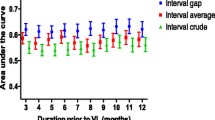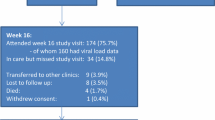Abstract
In adults living with HIV, pharmacy refill data are good predictors of virologic failure (VF). The utility of pharmacy refill data for predicting VF in adolescents has not been reported. We evaluated data from 291 adolescents on antiretroviral therapy. The main outcome measure was VF, defined as two consecutive HIV viral load measurements ≥ 400 copies/mL during 24-months of follow-up. Pharmacy refill non-adherence was defined as two consecutive refill adherence measurements < 95% during the same period. Fifty-three (18%) adolescents experienced VF. One hundred twenty-eight (44%) adolescents had refill non-adherence. Refill non-adherence had poor discriminative ability for indicating VF (receiver operating characteristic AUC = 0.60). Sensitivity and specificity for predicting VF was poor (60% (95% CI 46–74%) and 60% (95% CI 53–66%), respectively). The lack of a viable surrogate for VF in adolescents highlights the urgent need for more access to virologic testing and novel methods of monitoring adolescent treatment adherence.
Resumen
En los adultos que viven con el VIH, los datos en la farmacia sobre la renovación de recetas médicas son buenos predictores del fracaso virológico. La utilidad de los datos en la farmacia sobre la renovación de recetas médicas para predecir fracaso virológico en adolescentes no ha sido reportada. Se evaluaron los datos de 291 adolescentes en terapia antirretroviral. La principal medida de resultado fue el fracaso virológico, definida como dos medidas consecutivas de carga viral del VIH ≥ 400 copias/ml durante 24 meses de seguimiento. La no adherencia a la renovación de recetas médicas en la farmacia se definió como dos medidas consecutivas de adherencia a la renovación de recetas médicas < 95% durante el mismo período. Cincuenta y tres (18%) adolescentes tuvieron fracaso virológico. Ciento veintiocho (44%) adolescentes tuvieron no adherencia a la renovación de recetas médicas. El no-adherencia a la renovación de recetas médicas tuvo poca capacidad para indicar fracaso virológico (característica de funcionamiento del receptor AUC = 0.60). La sensibilidad y especificidad para predecir fracaso virológico fue deficiente (60% (95%: 46–74%) y 60% (95% CI 53–66%), respectivamente). La falta de un sustituto viable para el fracaso virológico en los adolescentes resalta la necesidad urgente para más acceso a las pruebas virológicas y métodos novedosos para monitorear la adherencia del tratamiento en los adolescentes.


Similar content being viewed by others
Abbreviations
- ART:
-
Anti-retroviral therapy
- AUC:
-
Area under the curve
- HIV:
-
Human immunodeficiency virus
- MEMS:
-
Medical event monitoring system
- ROC:
-
Receiver operating characteristic
- VF:
-
Virologic failure
References
WHO. Health for the World’s adolescents, A second chance in the second decade. 2017; http://apps.who.int/adolescent/second-decade/section3. Accessed 31 Aug 2017.
UNAIDS. Global report: UNAIDS report on the global AIDS epidemic 2013. Geneva2013.
Kasedde S, Luo C, McClure C, Chandan U. Reducing HIV and AIDS in adolescents: opportunities and challenges. Curr HIV/AIDS Rep. 2013;10(2):159–68.
Lowenthal ED, Bakeera-Kitaka S, Marukutira T, Chapman J, Goldrath K, Ferrand RA. Perinatally acquired HIV infection in adolescents from sub-Saharan Africa: a review of emerging challenges. Lancet Infect Dis. 2014;14(7):627–39.
Biglan A, Metzler CW, Wirt R, et al. Social and behavioral factors associated with high-risk sexual behavior among adolescents. J Behav Med. 1990;13(3):245–61.
Guiella G, Madise NJ. HIV/AIDS and sexual-risk behaviors among adolescents: factors influencing the use of condoms in Burkina Faso. Afr J Reprod Health. 2007;11(3):182–96.
Nachega JB, Hislop M, Nguyen H, et al. Antiretroviral therapy adherence, virologic and immunologic outcomes in adolescents compared with adults in southern Africa. J Acquir Immune Defic Syndr. 2009;51(1):65–71.
Gross R, Bilker WB, Friedman HM, Strom BL. Effect of adherence to newly initiated antiretroviral therapy on plasma viral load. AIDS. 2001;15(16):2109–17.
Rutstein SE, Golin CE, Wheeler SB, et al. On the front line of HIV virological monitoring: barriers and facilitators from a provider perspective in resource-limited settings. AIDS Care. 2016;28(1):1–10.
Rawizza HE, Chaplin B, Meloni ST, et al. Immunologic criteria are poor predictors of virologic outcome: implications for HIV treatment monitoring in resource-limited settings. Clin Infect Dis. 2011;53(12):1283–90.
Kantor R, Diero L, Delong A, et al. Misclassification of first-line antiretroviral treatment failure based on immunological monitoring of HIV infection in resource-limited settings. Clin Infect Dis. 2009;49(3):454–62.
Moore DM, Awor A, Downing R, et al. CD4 + T-cell count monitoring does not accurately identify HIV-infected adults with virologic failure receiving antiretroviral therapy. J Acquir Immune Defic Syndr. 2008;49(5):477–84.
van Oosterhout JJ, Brown L, Weigel R, et al. Diagnosis of antiretroviral therapy failure in Malawi: poor performance of clinical and immunological WHO criteria. Trop Med Int Health. 2009;14(8):856–61.
Davies MA, Boulle A, Eley B, et al. Accuracy of immunological criteria for identifying virological failure in children on antiretroviral therapy—the IeDEA Southern Africa Collaboration. Trop Med Int Health. 2011;16(11):1367–71.
Grossberg R, Gross R. Use of pharmacy refill data as a measure of antiretroviral adherence. Curr HIV/AIDS Rep. 2007;4(4):187–91.
Bisson GP, Gross R, Bellamy S, et al. Pharmacy refill adherence compared with CD4 count changes for monitoring HIV-infected adults on antiretroviral therapy. PLoS Med. 2008;5(5):e109.
Ministry of Health of Botswana. 2012 botswana national HIV & AIDS treatment guidelines. Gaborone: Government of Botswana; 2012.
Cramer JA. Microelectronic systems for monitoring and enhancing patient compliance with medication regimens. Drugs. 1995;49(3):321–7.
WHO. WHO case definitions of HIV for surveillance and revised clinical staging and immunologic classification of HIV-related disease in adults and children. 2007. http://www.who.int/hiv/pub/guidelines/HIVstaging150307.pdf. Accessed 10 June 2016.
Harris PA, Taylor R, Thielke R, Payne J, Gonzalez N, Conde JG. Research electronic data capture (REDCap)–a metadata-driven methodology and workflow process for providing translational research informatics support. J Biomed Inform. 2009;42(2):377–81.
Stata Statistical Software. Release 14 [computer program]. College Station: StataCorp LP; 2015.
Orrell C, Cohen K, Leisegang R, Bangsberg DR, Wood R, Maartens G. Comparison of six methods to estimate adherence in an ART-naive cohort in a resource-poor setting: which best predicts virological and resistance outcomes? AIDS Res Ther. 2017;14(1):20.
Martin D, Luz PM, Lake JE, et al. Pharmacy refill data can be used to predict virologic failure for patients on antiretroviral therapy in Brazil. J Int AIDS Soc. 2017;20(1):1–5.
Henegar CE, Westreich D, Maskew M, et al. Comparison of pharmacy-based measures of adherence to antiretroviral therapy as predictors of virological failure. AIDS Behav. 2015;19(4):612–8.
Sangeda RZ, Mosha F, Prosperi M, et al. Pharmacy refill adherence outperforms self-reported methods in predicting HIV therapy outcome in resource-limited settings. BMC Public Health. 2014;14:1035.
Abah IO, Ojeh VB, Musa J, et al. Clinical utility of pharmacy-based adherence measurement in predicting virologic outcomes in an adult HIV-infected cohort in Jos, North Central Nigeria. J Int Assoc Provid AIDS Care. 2016;15(1):77–83.
Vinikoor MJ, Schuttner L, Moyo C, et al. Short communication: late refills during the first year of antiretroviral therapy predict mortality and program failure among HIV-infected adults in urban Zambia. AIDS Res Hum Retroviruses. 2014;30(1):74–7.
Galano E, Turato ER, Succi RC, et al. Costs and benefits of secrecy: the dilemma experienced by adolescents seropositive for HIV. AIDS Care. 2017;29(3):394–8.
Hosek SG, Harper GW, Domanico R. Predictors of medication adherence among HIV-infected youth. Psychol Health Med. 2005;10(2):166–79.
Acknowledgements
The study team would like to thank the adolescent study participants and the staff at the Botswana- Baylor Children’s Clinical Centre of Excellence. We would also like to thank Alexandra Montesinos for translating the abstract into Spanish. This work was presented in part by Leah Genn at the Children’s Hospital of Philadelphia Research Institute Summer Scholar Program (CRISSP) 2015 Poster Session.
Funding
The first author’s work on this project was funded through the Children’s Hospital of Philadelphia Research Institute Summer Scholar Program (1R25HD082842-01). Study funding to establish this cohort was obtained from a CDC PEPFAR Public Health Effectiveness grant to the senior author. This work was supported by NIH K23 MH095669 to the senior author. Dr. Gross received support from the Penn Center for AIDS Research (P30 AI 045008). The funders did not play a role in study design, analysis, or the decision to publish this research.
Author information
Authors and Affiliations
Corresponding author
Ethics declarations
Conflict interest
None of the authors have conflicts of interest related to this manuscript.
Ethical Approval
All procedures were in accordance with the ethical standards of the institutional and national research committees and with the 1964 Helsinki Declaration and its later amendments and comparable ethical standards. The study was approved by the Botswana Health Research Development Committee and Institutional Review Boards at the University of Pennsylvania and Baylor College of Medicine. Written informed consent was obtained from a parent or guardian of each adolescent study participant and assent was obtained for each adolescent participant.
Electronic supplementary material
Below is the link to the electronic supplementary material.
Rights and permissions
About this article
Cite this article
Genn, L., Chapman, J., Okatch, H. et al. Pharmacy Refill Data are Poor Predictors of Virologic Treatment Outcomes in Adolescents with HIV in Botswana. AIDS Behav 23, 2130–2137 (2019). https://doi.org/10.1007/s10461-018-2325-9
Published:
Issue Date:
DOI: https://doi.org/10.1007/s10461-018-2325-9




